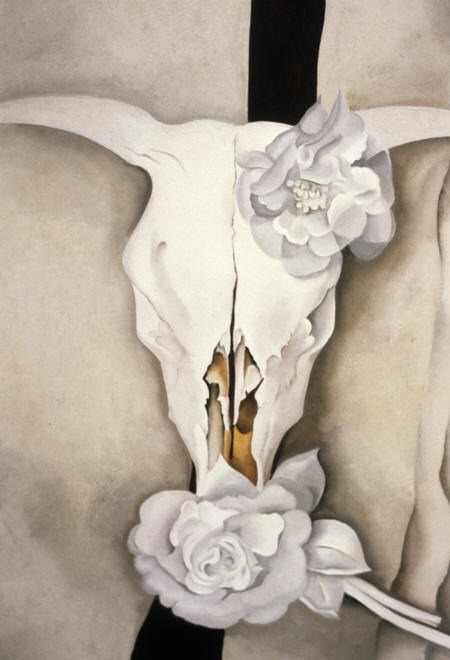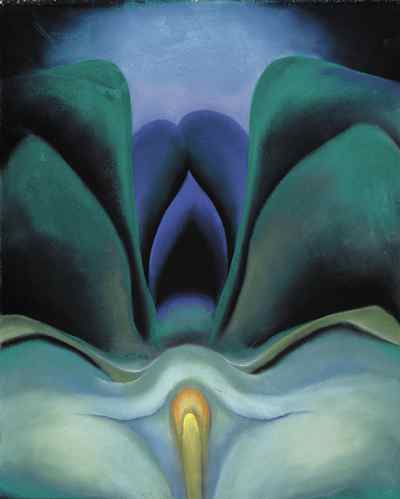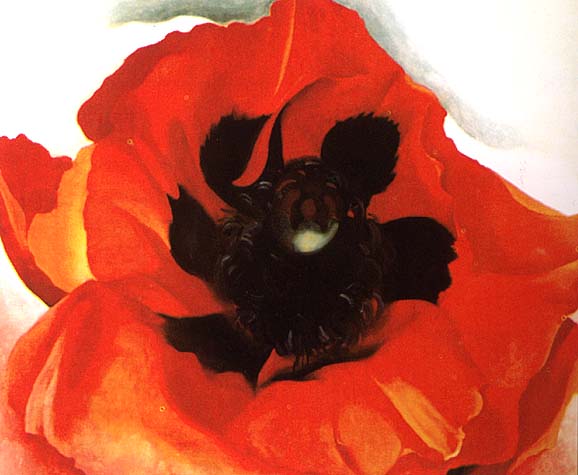-


 Georgia O'Keeffe
Georgia O'Keeffe
American
Artist
Among the great American artists of the 20th-century, Georgia O’Keeffe stands as one of the most compelling. For nearly a century, O’Keeffe’s representations of the beauty of the American landscape were a brave counterpoint to the chaotic images embraced by the art world. Her cityscapes and still life's filled the canvas with wild energy that gained her a following among the critics as well as the public. Though she has had many imitators, no one since has been able to paint with such intimacy and stark precision. With exceptionally keen powers of observation and great finesse with a paintbrush, Georgia O'Keeffe recorded subtle nuances of color, shape, and light that enlivened her paintings and attracted a wide audience.
Georgia O'Keeffe's primary subjects were landscapes, flowers, and bones, explored in series over several years and even decades. The images were drawn from her life experience and related either generally or specifically to places where she lived. Remarkably, she remained independent from shifting art trends and stayed true to her own vision, which was based on finding the essential, abstract forms in nature. Born in 1887 near Sun Prairie, Wisconsin, Georgia O'Keeffe received art training at the Art Institute of Chicago school (1905), the Art Students League of New York (1907–8), the University of Virginia (1912), and Columbia University's Teachers College, New York (1914–16). Georgia O'Keeffe became an art teacher and taught in various elementary schools, high schools, and colleges in Virginia, Texas, and South Carolina from 1911 to 1918. During one such position, Georgia O'Keeffe produced a remarkable series of charcoal drawings that led her art, and her career, in a new direction.
Georgia O'Keeffe was married to the pioneer photographer Alfred Stieglitz (1864-1946) in 1924. Alfred Stieglitz was 54 when Georgia arrived in New York, 23 years her senior. Educated in Berlin, he had studied engineering and photography before returning to the States at the turn of the century and opening the 291 gallery. He pioneered the art of photography, and single-handedly introduced America to the works of Picasso, Matisse, and Cezanne at the gallery, along with publishing his well respected "Camera Works" magazine. It was at Stieglitz's famed New York art gallery "291" that her charcoal drawings were first exhibited in 1916. The union lasted 22 years, until Stieglitz's death.
"If I could paint the flower exactly as I see it no one would see what I see because I would paint it small like the flower is small. So I said to myself - I'll paint what I see - what the flower is to me but I'll paint it big and they will be surprised into taking time to look at it - I will make even busy New Yorkers take time to see what I see of flowers. ...Well, I made you take time to look at what I saw and when you took time to really notice my flower you hung all your own associations with flowers on my flower and you write about my flower as if I think and see what you think and see of the flower - and I don't." -Georgia O'Keeffe
During the long winter months in New York Georgia O'Keeffe began to paint her very large flowers, some of her most popular work today. Georgia O'Keeffe completed her first enormous flower painting in 1924.The giant flower paintings were first exhibited in 1925. A Calla Lily painting would sell for $25,000 in 1928 and draw media attention to "O'Keeffe" like never before. Georgia's financial success would finally prove to her that an artist could make a living with a paintbrush. "I know now that most people are so closely concerned with themselves that they are not aware of their own individuality, I can see myself, and it has helped me to say what I want to say...in paint" ,stated Georgia O'Keeffe referring to the 300 photos taken of her by her husband.
After spending a summer in New Mexico, Georgia O'Keeffe, enthralled by the barren landscape and expansive skies of the desert, would explore the subject of animal bones in her paintings of the 1930s and 1940s. Georgia found the thin, dry air enabled her to see farther, and at times could see several approaching thunderstorms in the distance at once.
She affectionately referred to the land of northern New Mexico as "the faraway"...a place of stark beauty and infinite space. Soon after their arrival, Georgia O'Keeffe and Beck where invited to stay at Mable Dodge Luhan's ranch outside of Taos for the summer. Georgia O'Keeffe would go on many pack trips exploring the rugged mountains and deserts of the region.
On one trip Georgia O'Keeffe visited the D.H. Lawrence ranch and spent several weeks there. Just as with the flowers, Georgia O'Keeffe painted the bones magnified and captured the stillness and remoteness of them, while at the same time expressing a sense of beauty that lies within the desert.